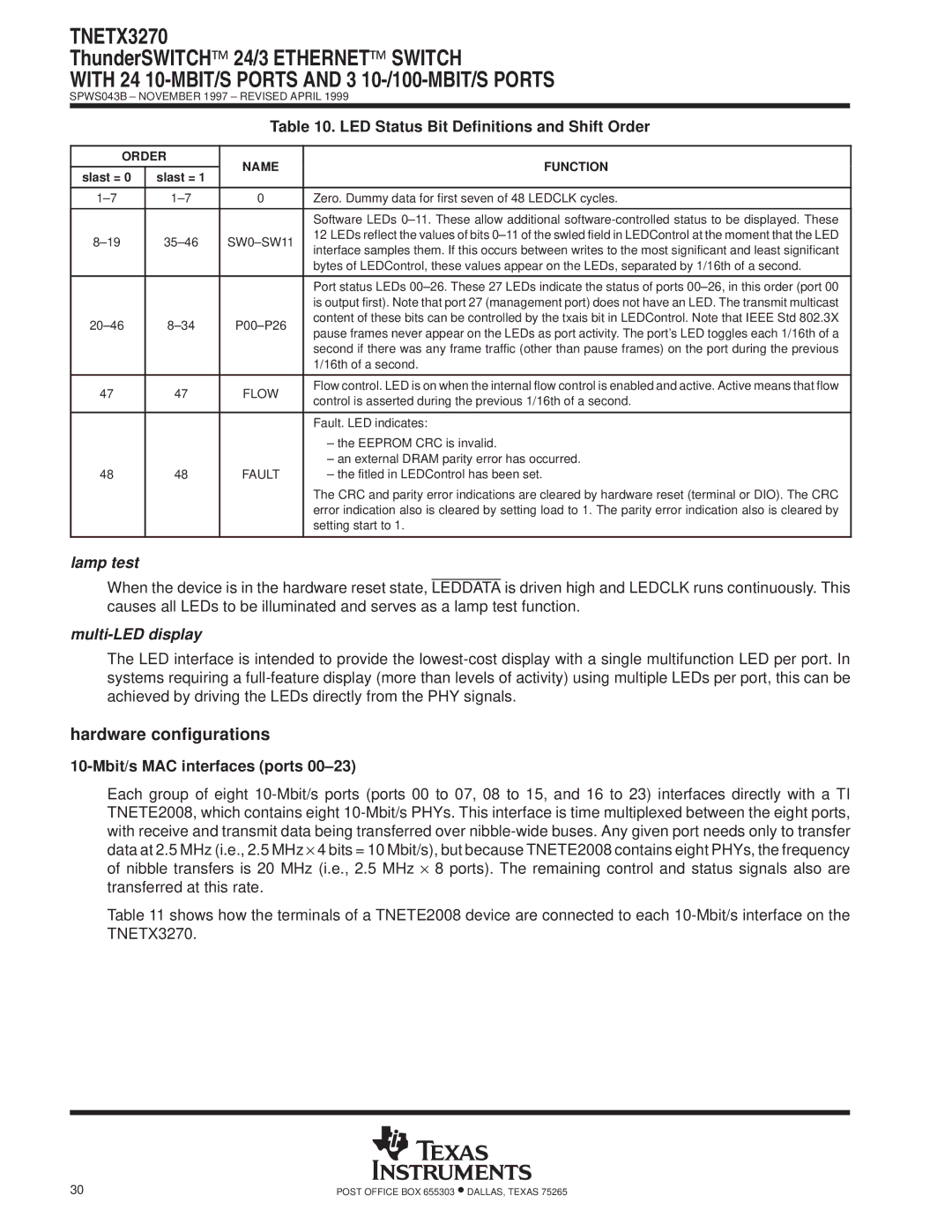
TNETX3270
ThunderSWITCH 24/3 ETHERNET SWITCH
WITH 24 10-MBIT/S PORTS AND 3 10-/100-MBIT/S PORTS
SPWS043B ± NOVEMBER 1997 ± REVISED APRIL 1999
Table 10. LED Status Bit Definitions and Shift Order
ORDER | NAME | FUNCTION | ||
|
| |||
slast = 0 | slast = 1 | |||
|
| |||
|
|
|
| |
1±7 | 1±7 | 0 | Zero. Dummy data for first seven of 48 LEDCLK cycles. | |
|
|
|
| |
|
|
| Software LEDs 0±11. These allow additional | |
8±19 | 35±46 | SW0±SW11 | 12 LEDs reflect the values of bits 0±11 of the swled field in LEDControl at the moment that the LED | |
interface samples them. If this occurs between writes to the most significant and least significant | ||||
|
|
| ||
|
|
| bytes of LEDControl, these values appear on the LEDs, separated by 1/16th of a second. | |
|
|
|
| |
|
|
| Port status LEDs 00±26. These 27 LEDs indicate the status of ports 00±26, in this order (port 00 | |
|
|
| is output first). Note that port 27 (management port) does not have an LED. The transmit multicast | |
20±46 | 8±34 | P00±P26 | content of these bits can be controlled by the txais bit in LEDControl. Note that IEEE Std 802.3X | |
pause frames never appear on the LEDs as port activity. The port's LED toggles each 1/16th of a | ||||
|
|
| ||
|
|
| second if there was any frame traffic (other than pause frames) on the port during the previous | |
|
|
| 1/16th of a second. | |
|
|
|
| |
47 | 47 | FLOW | Flow control. LED is on when the internal flow control is enabled and active. Active means that flow | |
control is asserted during the previous 1/16th of a second. | ||||
|
|
| ||
|
|
|
| |
|
|
| Fault. LED indicates: | |
|
|
| ± the EEPROM CRC is invalid. | |
|
|
| ± an external DRAM parity error has occurred. | |
48 | 48 | FAULT | ± the fitled in LEDControl has been set. | |
|
|
| The CRC and parity error indications are cleared by hardware reset (terminal or DIO). The CRC | |
|
|
| error indication also is cleared by setting load to 1. The parity error indication also is cleared by | |
|
|
| setting start to 1. | |
|
|
|
| |
lamp test
When the device is in the hardware reset state, LEDDATA is driven high and LEDCLK runs continuously. This causes all LEDs to be illuminated and serves as a lamp test function.
multi-LED display
The LED interface is intended to provide the
hardware configurations
10-Mbit/s MAC interfaces (ports 00±23)
Each group of eight
Table 11 shows how the terminals of a TNETE2008 device are connected to each
30 | POST OFFICE BOX 655303 •DALLAS, TEXAS 75265 |
